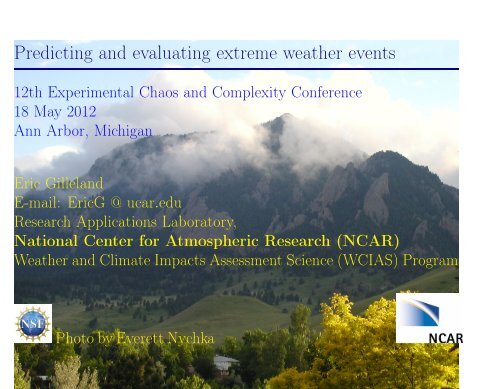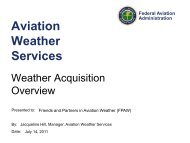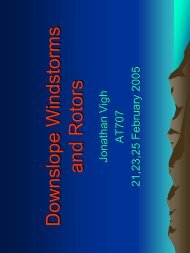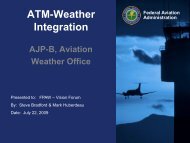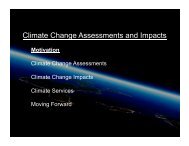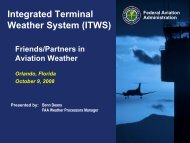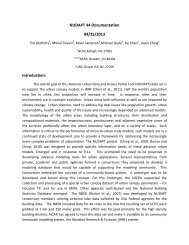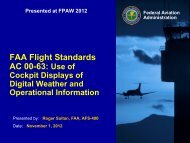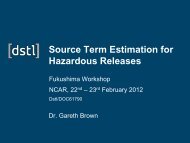Predicting and evaluating extreme weather events
Predicting and evaluating extreme weather events
Predicting and evaluating extreme weather events
You also want an ePaper? Increase the reach of your titles
YUMPU automatically turns print PDFs into web optimized ePapers that Google loves.
<strong>Predicting</strong> <strong>and</strong> <strong>evaluating</strong> <strong>extreme</strong> <strong>weather</strong> <strong>events</strong><br />
12th Experimental Chaos <strong>and</strong> Complexity Conference<br />
18 May 2012<br />
Ann Arbor, Michigan<br />
Eric Gillel<strong>and</strong><br />
E-mail: EricG @ ucar.edu<br />
Research Applications Laboratory,<br />
National Center for Atmospheric Research (NCAR)<br />
Weather <strong>and</strong> Climate Impacts Assessment Science (WCIAS) Program<br />
Photo by Everett Nychka
Motivation: Defining Extreme Events<br />
Pr{Winning ≥ $10, 000 in one drawing} ≈<br />
0.000001306024
Motivation: Defining Extreme Events<br />
Pr{Winning ≥ $10, 000 in one drawing} ≈<br />
0.000001306024<br />
Hereafter, simplify the problem by ignoring the fact we can win small<br />
amounts, etc.
Motivation<br />
Colorado Lottery<br />
Pr{Winning ≥ $10, 000 in one drawing} ≈<br />
0.000001306024<br />
In ten years, playing one ticket<br />
everyday, Pr{Winning ≥ $10, 000} ≈<br />
0.004793062
Motivation<br />
Colorado Lottery<br />
Pr{Winning ≥ $10, 000 in one drawing} ≈<br />
0.000001306024<br />
In ten years, playing one ticket<br />
everyday, Pr{Winning ≥ $10, 000} ≈<br />
0.004793062<br />
In 100 years ≈ 0.05003321<br />
In 1000 years ≈ 0.7686185
Motivation<br />
Colorado Lottery<br />
Pr{Winning ≥ $10, 000 in one drawing} ≈<br />
0.000001306024<br />
In 1000 years ≈ 0.7686185<br />
In ten years, playing one ticket<br />
everyday, Pr{Winning ≥ $10, 000} ≈<br />
0.004793062<br />
In 100 years ≈ 0.05003321<br />
Law of small numbers: <strong>events</strong> with small probably rarely happen, but<br />
have many opportunities to happen. These follow a<br />
Poisson distribution.
Motivation<br />
Colorado Lottery<br />
Can also talk about waiting time probability. The exponential<br />
distribution models this.
Motivation<br />
Colorado Lottery<br />
Can also talk about waiting time probability. The exponential<br />
distribution models this. For example, the probability that it will<br />
take longer than a year to win the lottery (at one ticket per day) is<br />
≈ 0.999523, longer than ten years ≈ 0.9952411, longer than 500 years<br />
≈ 0.7877987, <strong>and</strong> so on (decays exponentially, but with a very slow<br />
rate).
Motivation<br />
Colorado Lottery<br />
Another way to put it is that the expected number of years that it<br />
will take to win more than $10,000 in the lottery (buying one ticket<br />
per day) is about 2,096 years. If a ticket costs $1, then we can expect<br />
to spend $765,682.70 before winning at least $10,000.
Motivation<br />
Law of Large Numbers, Sum Stability, Central Limit Theorem<br />
And other results give theoretical support for use of the<br />
Normal distribution for analyzing most data.
Background: Extreme Value Theory (EVT)<br />
Extremal Types Theorem<br />
Theoretical support for using the Extreme Value Distributions<br />
(EVD’s) for extrema.<br />
• Valid for maxima over very large blocks, or<br />
• Excesses over a very high threshold.<br />
It is possible that there is no valid distribution for <strong>extreme</strong>s of a given<br />
r<strong>and</strong>om variable, but if one exists, it must be from the Generalized<br />
Extreme Value (GEV) family (block maxima) or the Generalized<br />
Pareto (GP) family (excesses over a high threshold). The two families<br />
are related.<br />
Poisson process allows for a nice characterization of the threshold<br />
excess model that neatly ties it back to the GEV distribution.
Background<br />
GEV<br />
Three parameters: location,<br />
scale <strong>and</strong> shape.<br />
Pr{M n ≤ z} =<br />
{<br />
exp − [ 1 + ξ ( )] }<br />
z−µ −1/ξ<br />
σ<br />
M n = max{X 1 , . . . , X n }<br />
Simulated Maxima from various df’s.
Background<br />
GEV<br />
Three parameters: location, scale <strong>and</strong> shape.<br />
{ [ ( )] } −1/ξ z − µ<br />
Pr{X ≤ z} = exp − 1 + ξ<br />
σ<br />
Three types of tail behavior:<br />
1. Bounded upper tail (ξ < 0, Weibull), Temperature, Wind Speed,<br />
Sea Level<br />
2. light tail (ξ = 0, Gumbel), <strong>and</strong><br />
3. heavy tail (ξ > 0, Fréchet), Stream Flow, Precipitation, Economic<br />
Impacts.<br />
Analogous situation for threshold excess approach, but focus is on the<br />
tail of these distributions.
Background<br />
Block Maxima vs. POT
Background<br />
Block Maxima vs. POT
Background<br />
Block Maxima vs. POT
Example<br />
Fort Collins, Colorado<br />
daily precipitation amount<br />
• Time series of daily precipitation<br />
amount (inches), 1900–1999.<br />
• Semi-arid region.<br />
• Marked annual cycle in precipitation<br />
(wettest in late spring/early summer,<br />
driest in winter).<br />
• No obvious long-term trend.<br />
• Recent flood, 28 July 1997.<br />
(substantial damage to<br />
Colorado State University)<br />
http://ccc.atmos.colostate.edu/~odie/rain.html
Examples<br />
Fort Collins, Colorado precipitation<br />
Gumbel hypothesis rejected at 5% level.<br />
ξ ≈ 0.17, 95% CI ≈ (0.01, 0.37)<br />
Fréchet (heavy tail)<br />
10-year return level<br />
≈ 2.8 in.<br />
Pr{M n ≥ 3 in} ≈ 0.08<br />
Return period for<br />
3 in. is ≈ 12.5 years
Extremes vs Extreme Impacts<br />
Extremes<br />
May or may not have an <strong>extreme</strong> impact depending on various factors<br />
(e.g., location, duration).<br />
Combinations of ordinary conditions<br />
Frozen ground <strong>and</strong> rain (e.g., 1959 Ohio statewide flood).
Weather Spells: Many ways to define them technically<br />
Photo from NCAR’s<br />
digital image library,<br />
DIO1492<br />
Do <strong>extreme</strong>s of lengths of spells follow EV df’s? (e.g., Cebrián <strong>and</strong><br />
Abaurrea (2006), J. Hydrometeorology, 7, 713–723, use a marked<br />
Poisson process approach)<br />
The same type of <strong>weather</strong> spell may or may not be important<br />
depending on where it occurs.
What is a drought?<br />
"a period of abnormally dry <strong>weather</strong> sufficiently prolonged for the lack<br />
of water to cause serious hydrologic imbalance in the affected area."<br />
-Glossary of Meteorology (1959)<br />
Meteorological–a measure of departure of precipitation from normal.<br />
Due to climatic differences, what might be considered a drought<br />
in one location of the country may not be a drought in another<br />
location.<br />
Agricultural–refers to a situation where the amount of moisture in<br />
the soil no longer meets the needs of a particular crop.<br />
Hydrological–occurs when surface <strong>and</strong> subsurface water supplies are<br />
below normal.<br />
Socioeconomic–refers to the situation that occurs when physical<br />
water shortages begin to affect people.<br />
http://www.wrh.noaa.gov/fgz/science/drought.php?wfo=fgz
Scale of Extreme Atmospheric Events<br />
2006 European Heat Wave F5 Tornado in Elie Manitoba<br />
(Fig. from KNMI) on Friday, June 22nd, 2007
Model/Reanalysis Resolution<br />
Banff<br />
●<br />
Calgary<br />
●<br />
~40−km CFDDA reanalysis (1985−2005)<br />
~200−km NCAR/NCEP reanalysis (1980−1999)<br />
~150−km CCSM3 regional climate model
Severe Weather<br />
As model resolution increases, some severe <strong>weather</strong> phenomena, such<br />
as hurricanes, can be predicted. However, other types of severe <strong>weather</strong><br />
may still require higher resolution.<br />
• Use large-scale indicators to analyze conditions ripe for severe<br />
<strong>weather</strong>.<br />
• Use climate models as drivers for finer scale <strong>weather</strong> models.<br />
• Statistical approach to current trends in observations.<br />
• Other?
Large-scale indicators for Severe <strong>weather</strong><br />
Non-severe<br />
Severe<br />
Significant<br />
Non-tornadic<br />
Significant<br />
Tornadic<br />
hail < 1.9 cm. (3/4 in.) diameter<br />
winds < 55 kts. no tornado<br />
Hail ≥ 1.9 cm. diameter<br />
winds ≤ 55 kts. <strong>and</strong> < 65 kts. or tornado<br />
Hail ≥ 5.07 cm. (2 in.) diameter<br />
Winds ≥ 65 kts.<br />
Same as sig. tornadic with F2 (or greater) tornado.
Large-scale indicators for Severe <strong>weather</strong><br />
CAPE×Shear WmSh=W max ×Shear (m 2 /s 2 )<br />
0.00000 0.00010 0.00020<br />
Non−severe<br />
Severe<br />
Significant Non−tornadic<br />
Significant Tornadic<br />
0.000 0.001 0.002 0.003<br />
0.0 0.2 0.4 0.6 0.8 1.0<br />
0.0 0.2 0.4 0.6 0.8 1.0<br />
W max = √ 2 · CAPE<br />
(m/s)<br />
0e+00 2e+05 4e+05<br />
0 2000 6000 10000
CAPE (W max ) <strong>and</strong> 0-6 km shear data, or indeed, output<br />
Median AM cape*shear reanalysis (1980−1999)<br />
25 30 35 40 45 50<br />
200000<br />
150000<br />
100000<br />
50000<br />
0<br />
−120 −110 −100 −90 −80 −70<br />
NCAR/NCEP global reanalysis: 1.875 o × 1.915 o lon-lat grid, > 17K<br />
points, 6-hourly, 1958–1999. See: Brooks et al. (2003), Atmos. Res.,<br />
67–68, 73–94.
Large-scale indicators for Severe <strong>weather</strong><br />
WmSh=W max × Shear<br />
AM Reanalysis (95-th quantile)<br />
20-yr GEV return level<br />
5000<br />
4000<br />
3000<br />
2000<br />
1000<br />
0<br />
Units are off here (shear is in knots instead of m/s, so take half of<br />
what you see).
Large-scale indicators for Severe <strong>weather</strong><br />
GEV(µ(t) = µ 0 + µ 1 t, σ, ξ),<br />
t = 0 (1958–1969), t = 1 (1970–1984), t = 2 (1985–1999).<br />
20-year return levels (i.e., 95-th percentile, m/s).<br />
1970−1984 vs 1958−1969<br />
1985−1999 vs 1958−1969<br />
1000<br />
1000<br />
500<br />
500<br />
0<br />
0<br />
−500<br />
−500<br />
Min. diff. from t = 0 to t = 2 is ≈ −750 m/s, max. is ≈ 400 m/s.<br />
25th percentile of diff’s is ≈ −100 m/s, 75th percentile is ≈ 75 m/s.<br />
−1000<br />
−1000
Large-scale indicators for Severe <strong>weather</strong><br />
Threshold excess modeling using Bayesian Hierarchical Models (BHM)<br />
Industrial Mathematical <strong>and</strong> Statistical Modeling (IMSM) Workshop<br />
for Graduate Students. Center for Research in Scientific<br />
Computation, Raleigh, North Carolina <strong>and</strong> the Statistical <strong>and</strong><br />
Applied Mathematical Sciences Institute (SAMSI), Research<br />
Triangle Park, North Carolina, 20-28 July 2009.<br />
Paper in Environmetrics, 22, 294–303:<br />
Heaton, M.J., M. Katzfuss, S. Ramach<strong>and</strong>ar, K. Pedings, Y.<br />
Li, E. Gillel<strong>and</strong>, E. Mannshardt-Shamseldin, <strong>and</strong> R.L. Smith,<br />
2009. Spatio-temporal models for <strong>extreme</strong> <strong>weather</strong> using largescale<br />
indicators.
Large-scale indicators for Severe <strong>weather</strong><br />
Three models of increasing complexity applied to threshold excesses<br />
(over the 95-th quantile of daily maximum WmSh).<br />
Model 1: Very Simple<br />
GPD with (ln) scale <strong>and</strong> shape parameter varying by region only.<br />
y td (s l )|ψ u(sl )(s l ), ξ(s l ) iid ∼ GPD(ψ u(sl )(s l ), ξ(s l )), where<br />
<strong>and</strong><br />
ln(ψ u(sl )(s l )) = α ψ + 1 sl ∈A ψ<br />
δ ψ ,<br />
ξ(s l ) = α ξ + 1 sl ∈A ξ<br />
δ ξ ,<br />
with A x somewhat arbitrarily chosen regions representing areas of<br />
exceptional values of these parameters as estimated via MLE at<br />
individual locations (this roughly translates to the “tornado alley").<br />
Priors for these parameters are taken as α ψ ∼ N(5.5, 1), δ ψ ∼ N(0, 1),<br />
α ξ ∼ N(0, 0.2 2 ), δ ξ ∼ N(0, 0.2 2 ).
Large-scale indicators for Severe <strong>weather</strong><br />
Model 2:<br />
GPD with Gaussian process for the (ln) scale parameter, <strong>and</strong> shape<br />
parameter varies according to region.<br />
y td (s l )|ψ u(sl )(s l ), ξ(s l ) iid ∼ GPD(ψ u(sl )(s l ), ξ(s l )), where<br />
ln(ψ u(sl )(s l )) ∼ GP ((µ ψ , τ 2 ψ, φ ψ ),<br />
<strong>and</strong><br />
ξ(s l ) = α ξ + 1 sl ∈A ξ<br />
δ ξ ,<br />
with Cov(ln(ψ(s l )), ln(ψ(s k ))) = τ 2 exp{−φ ψ ‖s l − s k ‖}, <strong>and</strong> ‖ · ‖<br />
the spherical distance in miles. Priors are the same as model 2, with<br />
additional priors for µ ψ ∼ Unif(−∞, ∞), τψ 2 ∼ IG(2.1, 3), <strong>and</strong><br />
φ ψ ∼ Unif(0.001, 0.1).
Large-scale indicators for Severe <strong>weather</strong><br />
Model 3:<br />
Point Process with temporal trend for location parameter, trivariate<br />
Gaussian process for location <strong>and</strong> (ln) scale parameters, <strong>and</strong> shape<br />
parameter varying according to region as in other two models.<br />
x td (s l )|x td (s l ) > u(s l ), β 0 (s l ), β 1 (s l ), σ(s l ), ξ(s l ) iid ∼<br />
where<br />
<strong>and</strong><br />
PP(β 0 (s l ) + β 1 (s l )t, σ(s l ), ξ(s l )),<br />
(β 0 (s l ), β 1 (s l ), ln(σ(s l ))) T ∼ GP 3 (µ M3 , φ M3 , Γ),<br />
ξ(s l ) = α ξ + 1 sl ∈A ξ<br />
δ ξ ,<br />
with GP 3 a trivariate Gaussian process induced via coregionalization<br />
(Gelf<strong>and</strong> et al. 2004), µ M3 = (µ β0 , µ β1 , µ σ ) T , φ M3 = (φ 1 , φ 2 , φ 3 ) T , <strong>and</strong><br />
Γ is a 3 × 3 lower triangular matrix with entries γ ij .
Large-scale indicators for Severe <strong>weather</strong><br />
Model 3 is best according to DIC (also most useful).<br />
ˆβ 1 Values<br />
Statistical Significance<br />
1.0<br />
Latitude<br />
20 25 30 35 40 45<br />
Latitude<br />
4<br />
20 25 30 35 40 45<br />
2<br />
0<br />
−2<br />
0.5<br />
0.0<br />
−0.5<br />
−1.0<br />
−120 −100 −80 −60<br />
−120 −100 −80 −60<br />
Longitude<br />
Longitude<br />
Is there practical significance with ˆβ 1 ranging only from about −4 to<br />
4 (e.g., 4 × 42 years is only 168 m/s difference in location parameter)?
Large-scale indicators for Severe <strong>weather</strong><br />
Twenty-year return level differences as calculated from the posterior<br />
means of Model 3 for 1999 vs 1958. Practical significance?<br />
Latitude<br />
20 25 30 35 40 45<br />
60<br />
40<br />
20<br />
0<br />
−20<br />
−120 −100 −80 −60<br />
Longitude
Large-scale indicators for Severe <strong>weather</strong><br />
Conditional EVA<br />
Heffernan <strong>and</strong> Tawn (2004), J. R. Statist. Soc. B, 66, 497–546.<br />
• Allows as many variates as you like.<br />
• Different assumptions than the usual multivariate EVA approach:<br />
condition on one variable’s being large, <strong>and</strong> find the joint conditional<br />
distribution of other variables.<br />
• Uncertainty obtained through bootstrapping (can be slow).<br />
• Model for positively associated pairs of r.v.’s has a simple form.<br />
• Semi-parametric model.<br />
• Theoretical justification for extrapolating beyond the range of the<br />
sample.
Large-scale indicators for Severe <strong>weather</strong><br />
Conditional EVA<br />
For simplicity, take the bivariate case, with r<strong>and</strong>om variables<br />
X <strong>and</strong> Y .<br />
1. Find marginal distributions, f X <strong>and</strong> f Y , using univariate EVT.<br />
2. Transform X <strong>and</strong> Y to the Gumbel scale (w/o loss of generality).<br />
3. Then, y|X = x = αx + x β Z, Z ∼ std. df., u a high threshold.<br />
Ẑ =<br />
y|X = x − ˆαx<br />
.<br />
Estimate α ∈ [0, 1] <strong>and</strong> β ∈ (−∞, 1) using, e.g., nls.<br />
4. Using<br />
x ˆβ<br />
Ẑ, characterize f(Ẑ) (e.g., kernel density, resampling).<br />
5. Sample at r<strong>and</strong>om from {Ẑi} n i=1 , calculate y (step 3), back-transform<br />
(step 1).
Large-scale indicators for Severe <strong>weather</strong><br />
Conditional EVA<br />
{ Y |X = x − αx<br />
Pr<br />
x β<br />
}<br />
≤ z|x > u<br />
−→ G(z)<br />
Joint tail behavior is characterized by α, β <strong>and</strong> G. G is not specified<br />
by theory, <strong>and</strong> there is no assumption of multivariate regular variation.
Large-scale indicators for Severe <strong>weather</strong><br />
Mean Predicted WmSh (m/s) conditioned on high field energy<br />
800<br />
600<br />
400<br />
200<br />
Performed using the texmex package in R
Summary/Conclusions/Discussion<br />
• Defining <strong>extreme</strong>s: Well-established statistical theory for <strong>events</strong><br />
with small probabilities of occurrence, but many chances to occur.<br />
• Weather spells are trickier to analyze: dependent on location <strong>and</strong><br />
definition.<br />
• Difficult to model severe <strong>weather</strong> <strong>events</strong> because of scale. Can use<br />
large-scale indicators of environments conducive to having severe<br />
<strong>weather</strong>.<br />
• Analyzing <strong>extreme</strong>s in the face of spatial dependence.<br />
– Multivariate EVA, Copulas, BHM, EV df’s with spatial covariates.<br />
Each is valid, <strong>and</strong> can be useful, but there are important<br />
drawbacks to each.<br />
– Conditional EVA (Heffernan <strong>and</strong> Tawn model) shows a lot of<br />
promise. Still some drawbacks, but less important for most<br />
studies.
http://www.assessment.ucar.edu/toolkit/<br />
Software
Discussion<br />
• How should <strong>extreme</strong> <strong>events</strong> be defined? Deadliness? Perceptionbased?<br />
Statistically? Economically? Other?<br />
• What is the relationship between changes in the mean <strong>and</strong> changes<br />
in <strong>extreme</strong>s? What about variability? Higher order moments?<br />
• If climate models project the df of atmospheric variables, then do<br />
they accurately portray the df’s? Enough so that functionals of<br />
interest, such as extrema, are correctly characterized?<br />
• If climate models only project the mean, then can anything be<br />
said about <strong>extreme</strong>s?<br />
• How can it be determined if small changes in high values of largescale<br />
indicators lead to a shift in the df of severe <strong>weather</strong><br />
conditional on the indicators?
Discussion<br />
• How do we verify climate models, especially for inferring about<br />
<strong>extreme</strong>s?<br />
• Extremes are often largely dependent on local conditions (e.g.,<br />
topography, surface conditions, atmospheric phenomena, etc.), as<br />
well as larger scale processes.<br />
• Can a metric for climate change pertaining to <strong>extreme</strong>s be<br />
developed that makes sense, <strong>and</strong> provides reasonably accurate<br />
information?<br />
• How can uncertainty be characterized? Is there too much<br />
uncertainty to make inferences about <strong>extreme</strong>s?<br />
• How can spatial structure be taken into account for <strong>extreme</strong>s?<br />
• Many <strong>extreme</strong> <strong>events</strong>, <strong>and</strong> especially <strong>extreme</strong> impact <strong>events</strong>, result<br />
from multivariate processes. How can this be addressed?


